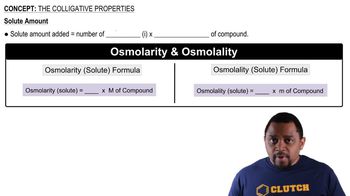Here are the essential concepts you must grasp in order to answer the question correctly.
Raoult's Law
Raoult's Law states that the vapor pressure of a solvent in a solution is directly proportional to the mole fraction of the solvent present. This principle is crucial for understanding how the addition of a solute, like LiCl, affects the vapor pressure of the solvent mixture (water and methanol) and allows for the calculation of the composition of the solution.
Recommended video:
Raoult's Law and Vapor Pressure
Colligative Properties
Colligative properties are properties of solutions that depend on the number of solute particles in a given amount of solvent, rather than the identity of the solute. These properties include vapor pressure lowering, boiling point elevation, and freezing point depression, which are essential for analyzing how the presence of LiCl alters the vapor pressures of the solvent mixture.
Recommended video:
Mass Percent Composition
Mass percent composition is a way to express the concentration of a component in a mixture, calculated as the mass of the component divided by the total mass of the solution, multiplied by 100. Understanding this concept is vital for determining the mass percent of water and methanol in the solution after applying Raoult's Law and analyzing the vapor pressures.
Recommended video:




